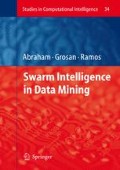Access this chapter
Tax calculation will be finalised at checkout
Purchases are for personal use only
Preview
Unable to display preview. Download preview PDF.
References
. E. Bonabeau, M. Dorigo, and G. Theraulaz (1999) Swarm Intelligence: From natural to artificial systems. Oxford University press, NY.
G.P. Babu, M. N. Murty (1993) A near-optimal initial seed value selection in K-Means algorithm using a genetic algorithm. Pattern Recognition Letters, v.14 n.10 pp. 763-769.
J.L. Deneubourg, S. Goss, N. Francs, A. Sendova-Franks, C. Detrain and L. Chretien (1991) The dynamics of collective sorting:Robot-Like Ant and Ant-Like Robot. In Proceedings First Conference on Simulation of adaptive Behavior: from animals to animats, edited by J.A. Meyer and S.W. Wilson, pp. 356-365. Cambridge, MA: MIT press.
L.O. Hall, I.B. Ozyurt, and J.C. Bezdek (1999) Clustering with a Genetically Optimized Approach. IEEE Trans-actions on Evolutionary Computation, Volume 3, No. 2, pp. 103-112.
. J. Handl, B. Meyer (2002) Improved Ant-Based Clustering and Sorting in a Document Retrieval Interface. Proc. of the 7th Int. Conf. on Parallel Problem Solving from Nature. pp. 913-923.
. D. R. Jones and M. A. Beltramo (1991) Solving partitioning problems with genetic algorithms. Proc. of the 4th ICGA, pp. 442-450.
. M. Kanade, L. O. Hall (2003) Fuzzy Ants as a Clustering Concept. Proc. of the 22nd Int. Conf. of the North American Fuzzy Information Processing Society. pp. 227-232.
. P. Kuntz, P. Layzell and D. Snyers (1997) A Colony of Ant-like Agents for Partitioning in VLSI Technology. Fourth European Conference on Artificial Life, MIT Press, pp. 417-424.
E. Lumer and B. Faieta (1994) Diversity and Adaptation in Populations of Clustering Ants. In Proceedings Third International Conference on Simulation of Adaptive Behavior: from animals to animats 3, Cambridge, Massachusetts MIT press, pp. 499-508.
N. Labroche, N. Monmarch é and G. Venturini (2002) A new clustering algorithm based on the chemical recognition system of ants. Proceedings of the European Conference on Artificial Intelligence, Lyon, France, pp. 345-349.
P. Lucic (2002) Modeling Transportation Systems using Concepts of Swarm Intelligence and Soft Computing. PhD thesis, Virginia Tech.
. N. Monmarch é , M. Silmane and G. Venturini (1999) AntClass:discovery of clusters in numeric data by an hybridization of an ant colony with k-means algorithm. Internal Report no. 213, Laboratoire ’Informatique de l’Universite.
N. Monmarch é , M. Slimane and G. Venturini (1999) On improving clustering in numerical databases with artificial ants. Advances in Artificial Life. 5th European Conference, ECAL’99. Proceedings Lecture Notes in Artificial Intelligence Vol. 1674, pp. 626-635.
. N. Monmarch é (2000) Algorithmes de Fourmis Artificielles: Applications à la Classification et à l’Optimisation. PhD thesis, Universit é France Rabelais.
V. Ramos, F. Muge and P. Pina (2002) Self-Organized Data and Image Retrieval as a Consequence of Inter-Dynamic Synergistic Relationships in Artificial Ant Colonies. Soft Computing Systems: Design, Management and Applications. 87, pp. 500-509.
. S. Schockaert, M. De Cock, C. Cornelis and E. E. Kerre (2004) Efficient Clustering with Fuzzy Ants. in Applied Computational Intelligence, World Scientific Press.
. D. Stirnimann and T. Lukacevic (2004) Adaptive Building Intelligence. Term Project, University of Applied Science Rapperswil.
Author information
Authors and Affiliations
Editor information
Editors and Affiliations
Rights and permissions
Copyright information
© 2006 Springer-Verlag Berlin Heidelberg
About this chapter
Cite this chapter
Kazemian, M., Ramezani, Y., Lucas, C., Moshiri, B. (2006). Swarm Clustering Based on Flowers Pollination by Artificial Bees. In: Abraham, A., Grosan, C., Ramos, V. (eds) Swarm Intelligence in Data Mining. Studies in Computational Intelligence, vol 34. Springer, Berlin, Heidelberg. https://doi.org/10.1007/978-3-540-34956-3_8
Download citation
DOI: https://doi.org/10.1007/978-3-540-34956-3_8
Publisher Name: Springer, Berlin, Heidelberg
Print ISBN: 978-3-540-34955-6
Online ISBN: 978-3-540-34956-3
eBook Packages: EngineeringEngineering (R0)

